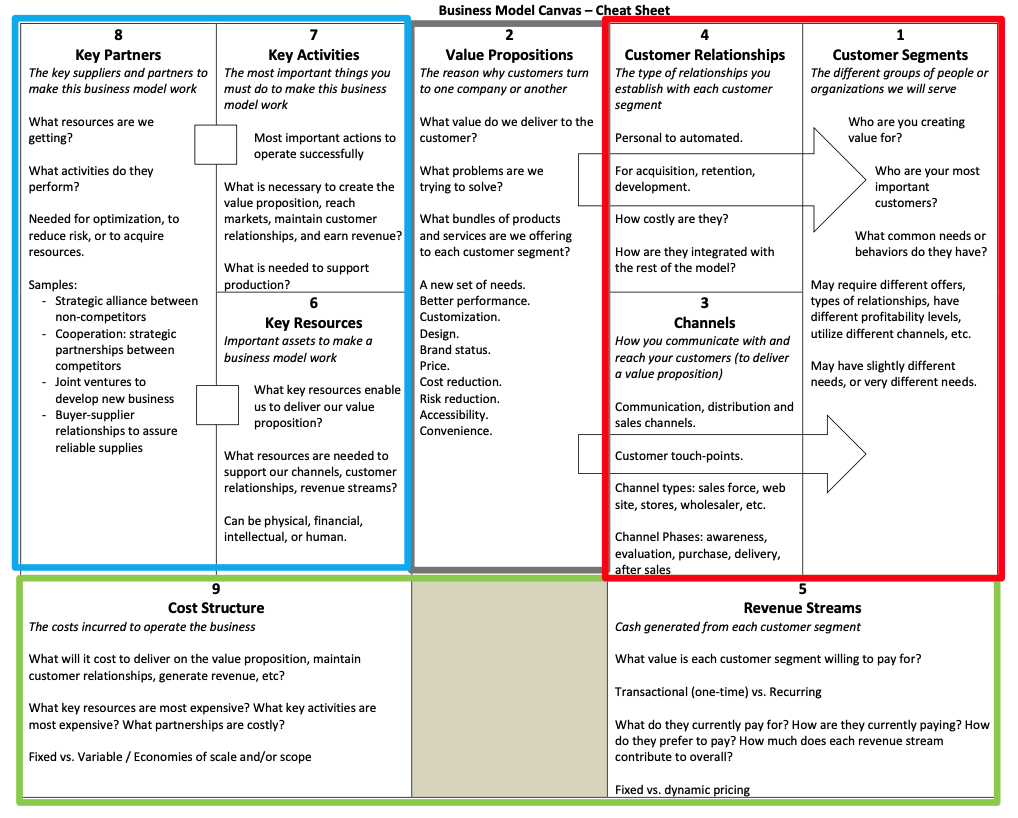Imagine one of your leaders comes to you with a new opportunity – say, a new product. The opportunity comes from a very small manufacturing company who is seeking a sales and marketing channel partner to distribute their product in North America.
How would you quickly come to a “No” or “Maybe” decision? (a “Yes” decision will come from further action/vetting, which would be flushed out during the Business Model Canvas review)
The first thing I would do is bring my leadership team together, have each of them pull out their copies of the Business Model Canvas – and walk through the blocks.
With some very basic questions (you’ll want to flush out your own that are specific to your situation), you should be able to come to a “No” or “Maybe” decision – leading to action items to determine if the “Maybe” turns into a ‘Yes”.

Here’s what that discussion / line of questioning might look like:
1. Customer Segments:
What segment is this new product for? All of them? One of them?
Will it boost an under-served segment? Will it allow us to reach a new segment?
Are these customer segments even interested? (an action item for your sales and marketing teams)
2. Value Propositions:
Does this new product fit the same value system and types of differentiation we currently offer our customers? For example, if our customers choose us because we have simple, easy-to-use products – does this new product fit that model?
Does it add some value or differentiation we currently lack? Does this new messaging resonate with the customer segments we are or will be chasing? (another action item for the marketing team)
3. Channels:
Does it easily fit in our channel strategy? For example, if your customers primarily get your products through distributors, will those distributors want to carry this new product? Or if your customers primarily buy from your online store, will they need more interaction/education before they purchase this new product?
4. Customer Relationships:
Following the last channel example, if your customers typically purchase your products with little-to-no interaction with you – can they still do that with this new product? Does it require a different level of pre-sales support?
If so, do you have the capability to deliver that? (more action items for your team)
5. Revenue Streams:
Can we price this product properly? Will it supply the margins we desire?
Again, back to the Customer Segments, will this product generate revenue from a segment that we know is still growing?
Does it fit our current pricing models and strategy? (more action items for sales, marketing and finance)
6. & 7. Key Resources/Activities/Processes:
To what degree (or not) will be have to alter our operations to receive, inventory, handle and ship the product?
Will we have to do anything fundamentally new (in any department) to transact a sale and get this product in our customers hands? (getting operations involved early could save you a lot of headaches later)
8. Key Partners:
Is this manufacturer capable of being a trusted partner? This is were the more traditional legal and financial vetting comes in.
Can they supply anticipated volumes in the short term? What about spikes? What about growth year over year? Again, lots of more traditional vetting to do here.
Do they have any alignment with your purpose and core values?
Lots of action items for your legal and financial teams.
9. Cost Structure:
Is there anything out of the normal here that we need to be aware of?
…
With one meeting that lasts maybe an hour or two – by using the Business Model Canvas as a central leadership team tool – you can have great, focused conversations where everyone is on the same page – and following the same thought pattern.
You should be able to gain consensus on a “No” or “Maybe” decision pretty quickly – with clear action items assigned to get that “Yes” or not.
…




